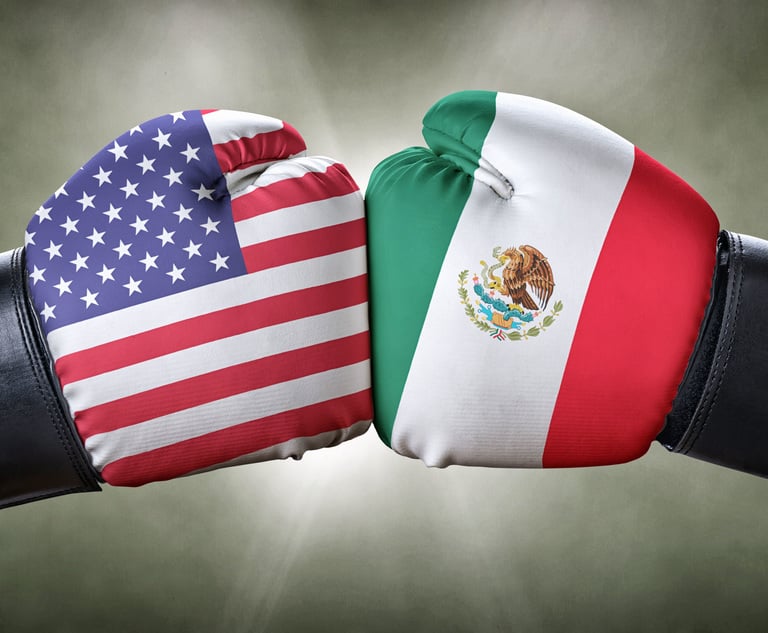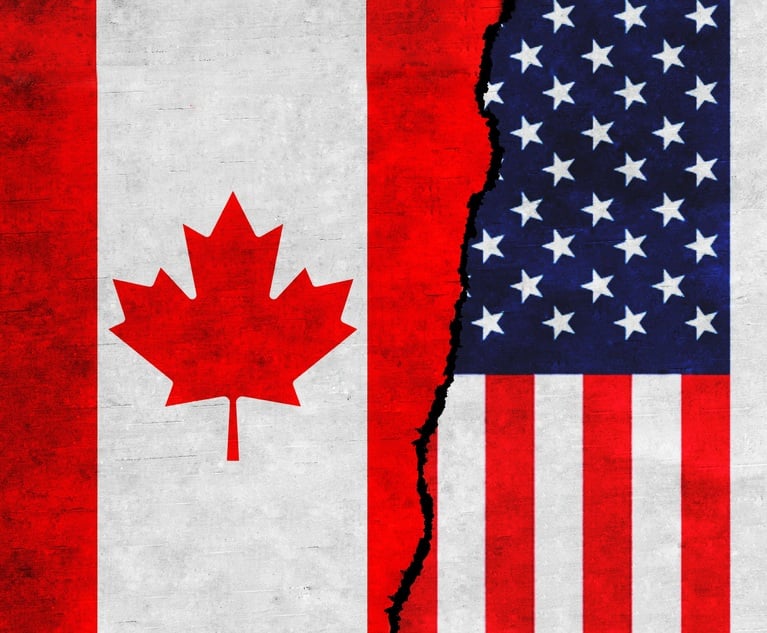Switzerland: United we stand
Switzerland's recent victory in the WTO dispute over US steel tariffs shows how smaller jurisdictions can benefit from working with other members to achieve a common goal, says Arthur Appleton
January 19, 2004 at 07:03 PM
6 minute read
On 10 November, 2003, the World Trade Organisation's (WTO's) appellate body handed down its decision in the case of US-Definitive Safeguard Measures on Imports of Certain Steel Products, giving Switzerland a victory in its first appearance as a party in a WTO dispute.
This high profile decision became binding between the parties on 10 December, 2003, with the adoption of the report by the WTO dispute settlement body. The importance of Switzerland's victory, and that of its co-complainants, became evident on 4 December, 2003, when the US announced that it would comply with the appellate body decision and lift its steel safeguard tariffs.
How does a small country like Switzerland participate successfully in WTO dispute settlement proceedings? It helps to find strong allies. What may appear to some as a David and Goliath story is, in fact, far from it; Switzerland was in powerful company, joining sides with the European communities – which led the fight against the US measures – and also with Japan, Korea, China, Norway, New Zealand and Brazil. Together they contested US safeguard tariffs of 8%-30% on 10 product categories with a combined value of several billion dollars.
WTO dispute settlement proceedings have up to four phases – consultations, a panel proceeding, an appellate proceeding and enforcement proceedings. A dispute can be resolved at any phase, and many disputes are resolved during consultations. Political and economic considerations can, however, lead a WTO member to defend a trade measure indefinitely, even if it knows that the measure is illegal.
For Switzerland, the WTO story began on 3 April, 2002, when it requested consultations with the US concerning the US safeguard measures. The consultations were unsuccessful. The European Commission (EC) was the first to request a panel, followed by Japan, Korea, China, Switzerland, Norway, New Zealand and Brazil.
When the parties were unable to resolve the dispute through bilateral consultations, they agreed to consolidate the proceedings with the same three panelists hearing the arguments of all parties. The co-complainants prevailed at the panel level, a ruling that the US appealed in August last year. In November 2003, the appellate body rejected six of the seven grounds raised by the US on appeal, handing the co-complainants, among them Switzerland, an unequivocal victory.
The appellate body's decision did not bring this dispute to an immediate end. The initial US reaction to the decision, both in Congress and in the White House, was somewhat defiant. This reaction probably had more to do with re-election politics, than with the legal merits of the US claim.
The US case was regarded by many WTO experts as legally weak, but integral to the Bush re-election strategy. Much of the US steel industry is based in Ohio, Pennsylvania and West Virginia, states that could be important for President Bush's re-election prospects in 2004. The US safeguard measures provided 21 months of protection to steel producers in these states, allowing for substantial industry restructuring and consolidation and earning the Bush administration some degree of political goodwill.
While the US safeguard measures may have helped its steel industry, such protectionism also has negative domestic consequences. As any consumer in Switzerland knows, Swiss agricultural protectionism, while important to Swiss farmers, raises the price consumers pay for food and makes it more costly for Swiss farmers and food producers to export their products. Likewise, the US steel safeguards were financially beneficial to steel companies, their workers and shareholders, but raised the price to US consumers of goods incorporating steel products affected by the tariff, such as automobiles and major appliances, and disadvantaged US manufacturers seeking to export products containing steel components affected by the safeguards.
These negative effects were apparent in the present dispute. The safeguard measures led US steel consumers to complain to the Government and increase their efforts to educate US voters about the negative effect of the safeguard measures on consumer prices and the significant unemployment that the safeguards were causing in US industries dependant on steel products affected by the measures.
Debate in the US on the domestic effects of its safeguard measures reached its peak shortly after circulation of the appellate body report on 10 November. With the adoption of the report by the Dispute Settlement Body (DSB) on 10 December, 2003, the way would arguably have been open, pursuant to Articles 8(2) and 8(3) of the Safeguards Agreement, for the EC, Switzerland and the other prevailing parties to suspend substantially equivalent trade concessions which they accord to the US. Capitalising on this opportunity, the EC had announced that on 15 December it would suspend $2.2bn in concessions accorded the US.
In a deft political move, the EC announced that it would target products that it could import from elsewhere: oranges, textiles and billiard tables. These products are produced in Florida and North Carolina, two states in which President Bush may be politically vulnerable in 2004. Although the Bush administration denied that the threatened retaliation influenced its decision to lift US tariffs, it would be very surprising if this were not the case given the political influence of the US steel industry and the economic difficulties it currently faces.
The safeguards decision is viewed by the trade community as a major but not unexpected loss for the US. But given the nature of the trade system, the question remains, how much did the US really lose?
The safeguard measures provided 21 months of protection for US industry. Furthermore, pursuant to WTO rules, although the US lost the dispute settlement proceeding, it is under no obligation to return the safeguard duties it collected or to compensate foreign manufacturers affected by its safeguard tariffs.
The effect of the US safeguard measures on the Swiss steel industry also illustrates the pernicious effect of safeguard measures. Switzerland is not a major exporter of steel products to the US, but it does export a substantial amount of steel to the European Union (EU). In addition, Swiss manufacturing firms purchase products from the EU made from steel that the EU has imported from third countries. The EU, afraid that its market would be overwhelmed by steel imports intended for the US market and diverted to the EU, imposed its own safeguard measures ranging from 20.6%-25%. This not only made it difficult for Swiss firms to export fabricated steel products to the EU, it also increased the price of steel manufactured in third countries and imported by Switzerland from the EU.
This means that, under the right circumstances, even a small country can benefit from the WTO's dispute settlement system, including its enforcement mechanism. Second, it shows the virtue of WTO members working together to address common trade problems. Third, it should provide a better indication to Switzerland of possible areas where the dispute settlement system and the agreement on safeguards need to be reformed.
Arthur Appleton is of counsel at the Geneva office of White & Case.
This content has been archived. It is available through our partners, LexisNexis® and Bloomberg Law.
To view this content, please continue to their sites.
Not a Lexis Subscriber?
Subscribe Now
Not a Bloomberg Law Subscriber?
Subscribe Now
NOT FOR REPRINT
© 2025 ALM Global, LLC, All Rights Reserved. Request academic re-use from www.copyright.com. All other uses, submit a request to [email protected]. For more information visit Asset & Logo Licensing.
You Might Like
View All
Big Law Sidelined as Asian IPOs in New York Dominated by Small Cap Listings

X-odus: Why Germany’s Federal Court of Justice and Others Are Leaving X

Mexican Lawyers On Speed-Dial as Trump Floats ‘Day One’ Tariffs

Threat of Trump Tariffs Is Sign Canada Needs to Wean Off Reliance on Trade with U.S., Trade Lawyers Say
5 minute readTrending Stories
Who Got The Work
J. Brugh Lower of Gibbons has entered an appearance for industrial equipment supplier Devco Corporation in a pending trademark infringement lawsuit. The suit, accusing the defendant of selling knock-off Graco products, was filed Dec. 18 in New Jersey District Court by Rivkin Radler on behalf of Graco Inc. and Graco Minnesota. The case, assigned to U.S. District Judge Zahid N. Quraishi, is 3:24-cv-11294, Graco Inc. et al v. Devco Corporation.
Who Got The Work
Rebecca Maller-Stein and Kent A. Yalowitz of Arnold & Porter Kaye Scholer have entered their appearances for Hanaco Venture Capital and its executives, Lior Prosor and David Frankel, in a pending securities lawsuit. The action, filed on Dec. 24 in New York Southern District Court by Zell, Aron & Co. on behalf of Goldeneye Advisors, accuses the defendants of negligently and fraudulently managing the plaintiff's $1 million investment. The case, assigned to U.S. District Judge Vernon S. Broderick, is 1:24-cv-09918, Goldeneye Advisors, LLC v. Hanaco Venture Capital, Ltd. et al.
Who Got The Work
Attorneys from A&O Shearman has stepped in as defense counsel for Toronto-Dominion Bank and other defendants in a pending securities class action. The suit, filed Dec. 11 in New York Southern District Court by Bleichmar Fonti & Auld, accuses the defendants of concealing the bank's 'pervasive' deficiencies in regards to its compliance with the Bank Secrecy Act and the quality of its anti-money laundering controls. The case, assigned to U.S. District Judge Arun Subramanian, is 1:24-cv-09445, Gonzalez v. The Toronto-Dominion Bank et al.
Who Got The Work
Crown Castle International, a Pennsylvania company providing shared communications infrastructure, has turned to Luke D. Wolf of Gordon Rees Scully Mansukhani to fend off a pending breach-of-contract lawsuit. The court action, filed Nov. 25 in Michigan Eastern District Court by Hooper Hathaway PC on behalf of The Town Residences LLC, accuses Crown Castle of failing to transfer approximately $30,000 in utility payments from T-Mobile in breach of a roof-top lease and assignment agreement. The case, assigned to U.S. District Judge Susan K. Declercq, is 2:24-cv-13131, The Town Residences LLC v. T-Mobile US, Inc. et al.
Who Got The Work
Wilfred P. Coronato and Daniel M. Schwartz of McCarter & English have stepped in as defense counsel to Electrolux Home Products Inc. in a pending product liability lawsuit. The court action, filed Nov. 26 in New York Eastern District Court by Poulos Lopiccolo PC and Nagel Rice LLP on behalf of David Stern, alleges that the defendant's refrigerators’ drawers and shelving repeatedly break and fall apart within months after purchase. The case, assigned to U.S. District Judge Joan M. Azrack, is 2:24-cv-08204, Stern v. Electrolux Home Products, Inc.
Featured Firms
Law Offices of Gary Martin Hays & Associates, P.C.
(470) 294-1674
Law Offices of Mark E. Salomone
(857) 444-6468
Smith & Hassler
(713) 739-1250








